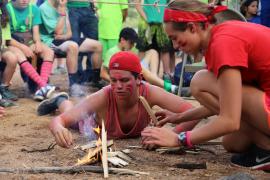Family camps have become increasingly prevalent over the past several years. The number of camps offering family programs has exploded since the early 90s; reports of increases in family camps range from 215 percent (Sweet 2007) to 500 percent (Tevis 2005) in the last sixteen years. More families are seeking opportunities to spend time together (Shaw and Dawson 2001), and camp providers are responding to this desire by providing more family programs. Camp providers are seeing family programs not only as a way to increase revenue to their camps, but also as a way to make a difference and help families build stronger relationships with one another and experience the benefits of camp together (Agate and Covey 2007). Scant research has been done regarding family camps, thus, research is needed to help providers learn how they can improve the experiences they are providing for families.
Background
In a meta-analysis of family camp research, Agate and Covey (2007) categorized reasons that families attend family camps into three subgroups: (1) therapeutic or intervention; (2) prevention, enrichment, or maintenance; and (3) vacation. They also identified the following categories of benefits families receive from family camp attendance: improving family interaction, nurturing relationships, providing social benefits, and addressing specific issues. They found that families receive both immediate and long-term benefits from attending family camps. [For a more complete discussion of reasons for attendance and benefits, see Agate and Covey (2007).]
Current Study
At the 2009 ACA conference, two colleagues and I conducted an education session about creating and improving experiences for families at camp. Through our focus group discussion with the twenty-five family camp providers, the following concerns were identified as challenges when providing family programs: programming involving all family members, parent issues, rules, retention of families, potential harmful effects of issue-based camps, perceived value, and housing. The larger group then broke into smaller groups (three to five people) to brainstorm possible avenues for dealing with these challenges. Several ideas were generated by the groups that can be useful for those dealing with these various problems when providing family programs. The following is a summary of some ideas that were formulated by the small groups.
Programming Involving All Family Members
Family camps must decide what types of families they will cater to, and then focus on providing a good program for that group. Maybe a camp does not need to be a great camp for all families: perhaps they offer an excellent program for families with young children. They can either choose to excel in that and be clear in their advertising that those are the families their camp is geared toward, or they can invest in developing a program that can also be enjoyed by families with older children as well. Whatever the camp chooses to do, they must be clear in advertising their focus and strengths so that people will come with realistic expectations about the experience they will have. Sarah Taylor Agate, M.S., C.F.L.E. and Dorothy Schmalz, Ph.D.
Suggested Solution: Whatever stage of family a camp chooses to focus on, they must find out what needs those families face if they want to offer an enjoyable and safe camp experience for them. Families face different needs at different stages of the family life cycle, and also according to the family type and structure (i.e., single-parent families, GLBT families, intergenerational families). Part of recognizing family needs and programming for all family members is to look at the natural flow of the daily routine of the families for which a camp is providing a program. For example, if a camp is for families with young children, they will not want to play activities involving toddlers at 1:00 in the afternoon since that is when most children that age take naps.
Parents as Participants
Some of the concerns camp providers of family programs discussed revolved around the fact that parents are now participants; parents may not want to be involved in the program, not respect staff or the camp rules, or have a hard time trusting the staff members. Among the situations providers drew from included frustration with parents approaching staff and activity counselors as daycare providers or babysitters for their small children.
Suggested Solution: The rules and camp program structure must be made clear to parents (both in marketing before arrival and also once they are at camp). Some camp programs may be designed to encourage families to participate in activities together, while others may focus on individual interests during activities with opportunities for family time at different times during the day. In the case of the camp that wants to encourage families participating together, camp directors should clearly communicate to parents that they (parents) are encouraged to participate in activities with their children and that camp staff and activity counselors are not expected to watch children while the parents are doing other activities.
Camp providers also expressed concern regarding parents questioning camp rules and the staff’s authority in enforcing camp rules. It can be difficult for staff members to enforce rules with children participants whose parents do not recognize the staff’s authority and support their children’s behavior or to enforce rules with the parents themselves.
Suggested Solution: Again, it must be made clear that the camp rules do not change for the family. The rules are in place for a reason (whether that is to keep participants safe, to follow a law, or because of camp tradition) and must be followed by all campers to ensure an enjoyable program for all of the participants.
Parents and Rules
Camp providers often have challenges enforcing certain rules once parents become participants. Access to technologies such as the Internet and cell phones and adult use of alcohol at camp are common issues.
Suggested Solution: If a camp feels that technology interferes with their program, but parents need to be "connected," they could have "technology time" for an hour where parents are able to use cell phones or check e-mail or a "technology café" where parents could go to check messages or make necessary calls. Similar to technology, camps must decide how alcohol use fits with their mission as a camp. If alcohol use is contrary to the mission of the camp, the camp must make it clear to participants before they come that no alcohol is allowed. If alcohol access suits the mission of the camp, some camps have a "happy hour" where the parents may come and have drinks with one another in the evening. With the rules regarding all of these issues, camps must take the responsibility to be clear about why they have the rules they do and help parents be aware of those rules before they arrive. Furthermore, camp rules should be enforced consistently throughout camp and with all campers while camp is in session.
Retention of Families
One way to keep families coming back is to provide an enjoyable experience for them while they are at camp. If someone has a great time at camp, they will likely want to come back (and will tell their friends that they should come, too). If they have a mediocre time at camp, they may choose to spend their hard-earned and limited vacation money at a different place next year. Especially in these financially- challenging times, camps need to offer competitive programs that families will truly enjoy if they want people to spend their limited resources on them.
Suggested Solution: Conducting evaluations with campers (both those who return and those who do not) can help camp directors become aware of what aspects of the camp experience were enjoyable for participants as well as what could be improved. This type of evaluation can also help camps narrow in on their target market, their mission, their rules, and why they are doing what they are doing. Camps may also want to look at what similar camps are offering, and at what price, to determine how competitive their own prices and program are. Additionally, keeping families involved with one’s camp community throughout the year can also help get and keep families excited about returning to camp. Sending out a newsletter or having periodic "family days" can keep families engaged with a camp community and each other and help foster their desire to continue to be involved with the camp.
Future Research
Family camps are increasing in number, and are gaining interest among consumers. Yet, little attention has been paid to family camps in reviews, evaluations, and research. Family camp providers seem to want as much information as they can get to help them offer the best possible programs to families. Current researchers should explore the overall phenomenon of family camps, and pilot some studies examining why families are attending family camps, what they gain from attending, and the challenges they face in attending or while at camp together. Studies should also continue to explore the issues that camp providers face when facilitating family programs, as well as what camps can do to overcome those challenges. Another direction for future research might be to explore what camps can do to improve experiences for families at camp. Family camps can be empowering experiences for families, and future research in this area can help camp providers facilitate enjoyable and meaningful experiences for the families they serve.
References
Agate, S., & Covey, C.D. (2007). Family camps: An overview of benefits and issues of camps and programs for families. Child and Adolescent Psychiatric Clinics of North America, 16(4), 921-937.
Balen, R. (1996). Activity camps for children with cancer. Children and Society, 10(4), 317-323.
Shaw, S.M., & Dawson, D. (2001). Purposive leisure: Examining parental discourses on family activities. Leisure Sciences, 23, 217-231.
Sweet, D. (2007). Family camps. Retrieved February 1, 2009 from http://camping.about.com/b/2007/05/29/family-camps-2.htm.
Tevis, P. (2005). Great family camps. Retrieved February 1, 2009 from http://familyfun.go.com/family-travel/places/feature/famf39camp/famf39ca....
Sarah Taylor Agate, M.S., C.F.L.E., is currently finishing her Ph.D. at Clemson University in Parks, Recreation, and Tourism Management. Her camp experience includes two years administrative work with the Boy Scout’s Florida Sea Base. Her research focuses on creating enjoyable recreation experiences for families. She can be reached at [email protected].
Dorothy Schmalz, Ph.D., is an assistant professor in the Department of Parks, Recreation, and Tourism Management at Clemson University. She has experience as a camper, junior and senior staff member, and as a Board member. She teaches and researches topics in human development, diversity, and nonprofit leadership. She can be reached at [email protected].
Originally published in the 2010 March/April issue of Camping Magazine.


